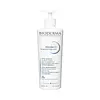What's inside
What's inside
 Key Ingredients
Key Ingredients

 Benefits
Benefits

 Concerns
Concerns

 Ingredients Side-by-side
Ingredients Side-by-side

Water
Skin ConditioningGlycerin
HumectantParaffinum Liquidum
EmollientHelianthus Annuus Seed Oil
EmollientBehenyl Alcohol
EmollientSucrose Stearate
EmollientCanola Oil
EmollientHydroxyethyl Acrylate/Sodium Acryloyldimethyl Taurate Copolymer
Emulsion StabilisingPentylene Glycol
Skin ConditioningBeta-Sitosterol
Emulsion StabilisingXylitol
HumectantZinc Gluconate
Skin ConditioningAcrylates/C10-30 Alkyl Acrylate Crosspolymer
Emulsion StabilisingPalmitamide Mea
1,2-Hexanediol
Skin ConditioningCaprylyl Glycol
EmollientSodium Citrate
BufferingMannitol
HumectantRhamnose
HumectantSodium Lauroyl Lactylate
EmulsifyingSodium Hydroxide
BufferingPolysorbate 60
EmulsifyingSorbitan Isostearate
EmulsifyingTocopherol
AntioxidantPhytosphingosine
Skin ConditioningCeramide NP
Skin ConditioningEthylhexylglycerin
Skin ConditioningCeramide AP
Skin ConditioningCholesterol
EmollientCarbomer
Emulsion StabilisingXanthan Gum
EmulsifyingFructooligosaccharides
HumectantCaprylic/Capric Triglyceride
MaskingLaminaria Ochroleuca Extract
Skin ConditioningCitric Acid
BufferingCeramide EOP
Skin ConditioningWater, Glycerin, Paraffinum Liquidum, Helianthus Annuus Seed Oil, Behenyl Alcohol, Sucrose Stearate, Canola Oil, Hydroxyethyl Acrylate/Sodium Acryloyldimethyl Taurate Copolymer, Pentylene Glycol, Beta-Sitosterol, Xylitol, Zinc Gluconate, Acrylates/C10-30 Alkyl Acrylate Crosspolymer, Palmitamide Mea, 1,2-Hexanediol, Caprylyl Glycol, Sodium Citrate, Mannitol, Rhamnose, Sodium Lauroyl Lactylate, Sodium Hydroxide, Polysorbate 60, Sorbitan Isostearate, Tocopherol, Phytosphingosine, Ceramide NP, Ethylhexylglycerin, Ceramide AP, Cholesterol, Carbomer, Xanthan Gum, Fructooligosaccharides, Caprylic/Capric Triglyceride, Laminaria Ochroleuca Extract, Citric Acid, Ceramide EOP
Water
Skin ConditioningButylene Glycol
HumectantGlycerin
HumectantCetyl Ethylhexanoate
EmollientDimethicone
EmollientPolyglyceryl-3 Methylglucose Distearate
EmulsifyingCetearyl Alcohol
EmollientButyrospermum Parkii Butter
Skin ConditioningGlyceryl Stearate Citrate
EmollientPanthenol
Skin Conditioning1,2-Hexanediol
Skin ConditioningGlyceryl Stearate
EmollientHydroxypropyl Starch Phosphate
Polyacrylate-13
Parfum
MaskingSodium Stearoyl Glutamate
CleansingPolyisobutene
Hydrogenated Lecithin
EmulsifyingTocopheryl Acetate
AntioxidantGlyceryl Caprylate
EmollientStearic Acid
CleansingPanax Ginseng Root Water
MaskingPalmitic Acid
EmollientDisodium EDTA
Ethylhexylglycerin
Skin ConditioningPolysorbate 20
EmulsifyingSorbitan Isostearate
EmulsifyingSimmondsia Chinensis Seed Oil
EmollientBupleurum Falcatum Root Extract
Skin ConditioningAngelica Acutiloba Root Extract
Skin ConditioningOphiopogon Japonicus Root Extract
Skin ConditioningMadecassoside
AntioxidantMyristic Acid
Cleansing7-Dehydrocholesterol
Emulsion StabilisingGluconolactone
Skin ConditioningLauric Acid
CleansingTocopherol
AntioxidantWater, Butylene Glycol, Glycerin, Cetyl Ethylhexanoate, Dimethicone, Polyglyceryl-3 Methylglucose Distearate, Cetearyl Alcohol, Butyrospermum Parkii Butter, Glyceryl Stearate Citrate, Panthenol, 1,2-Hexanediol, Glyceryl Stearate, Hydroxypropyl Starch Phosphate, Polyacrylate-13, Parfum, Sodium Stearoyl Glutamate, Polyisobutene, Hydrogenated Lecithin, Tocopheryl Acetate, Glyceryl Caprylate, Stearic Acid, Panax Ginseng Root Water, Palmitic Acid, Disodium EDTA, Ethylhexylglycerin, Polysorbate 20, Sorbitan Isostearate, Simmondsia Chinensis Seed Oil, Bupleurum Falcatum Root Extract, Angelica Acutiloba Root Extract, Ophiopogon Japonicus Root Extract, Madecassoside, Myristic Acid, 7-Dehydrocholesterol, Gluconolactone, Lauric Acid, Tocopherol
 Reviews
Reviews

Ingredients Explained
These ingredients are found in both products.
Ingredients higher up in an ingredient list are typically present in a larger amount.
1,2-Hexanediol is a synthetic liquid and another multi-functional powerhouse.
It is a:
- Humectant, drawing moisture into the skin
- Emollient, helping to soften skin
- Solvent, dispersing and stabilizing formulas
- Preservative booster, enhancing the antimicrobial activity of other preservatives
Ethylhexylglycerin (we can't pronounce this either) is commonly used as a preservative and skin softener. It is derived from glyceryl.
You might see Ethylhexylglycerin often paired with other preservatives such as phenoxyethanol. Ethylhexylglycerin has been found to increase the effectiveness of these other preservatives.
Glycerin is already naturally found in your skin. It helps moisturize and protect your skin.
A study from 2016 found glycerin to be more effective as a humectant than AHAs and hyaluronic acid.
As a humectant, it helps the skin stay hydrated by pulling moisture to your skin. The low molecular weight of glycerin allows it to pull moisture into the deeper layers of your skin.
Hydrated skin improves your skin barrier; Your skin barrier helps protect against irritants and bacteria.
Glycerin has also been found to have antimicrobial and antiviral properties. Due to these properties, glycerin is often used in wound and burn treatments.
In cosmetics, glycerin is usually derived from plants such as soybean or palm. However, it can also be sourced from animals, such as tallow or animal fat.
This ingredient is organic, colorless, odorless, and non-toxic.
Glycerin is the name for this ingredient in American English. British English uses Glycerol/Glycerine.
Learn more about GlycerinSorbitan Isostearate is an emulsifer and cleaning agent. It is created from isostearic acid and sorbitol.
As an emulsifier, Sorbitan Isostearate prevents oils and water from separating.
Due to its isostearic acid base, it may not be safe for Malassezia or fungal acne.
Learn more about Sorbitan IsostearateTocopherol (also known as Vitamin E) is a common antioxidant used to help protect the skin from free-radicals and strengthen the skin barrier. It's also fat soluble - this means our skin is great at absorbing it.
Vitamin E also helps keep your natural skin lipids healthy. Your lipid skin barrier naturally consists of lipids, ceramides, and fatty acids. Vitamin E offers extra protection for your skin’s lipid barrier, keeping your skin healthy and nourished.
Another benefit is a bit of UV protection. Vitamin E helps reduce the damage caused by UVB rays. (It should not replace your sunscreen). Combining it with Vitamin C can decrease sunburned cells and hyperpigmentation after UV exposure.
You might have noticed Vitamin E + C often paired together. This is because it is great at stabilizing Vitamin C. Using the two together helps increase the effectiveness of both ingredients.
There are often claims that Vitamin E can reduce/prevent scarring, but these claims haven't been confirmed by scientific research.
Learn more about TocopherolWater. It's the most common cosmetic ingredient of all. You'll usually see it at the top of ingredient lists, meaning that it makes up the largest part of the product.
So why is it so popular? Water most often acts as a solvent - this means that it helps dissolve other ingredients into the formulation.
You'll also recognize water as that liquid we all need to stay alive. If you see this, drink a glass of water. Stay hydrated!
Learn more about Water